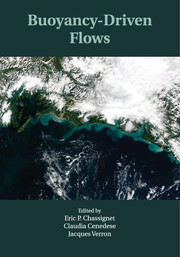Book contents
- Frontmatter
- Contents
- List of Contributors
- Introduction
- 1 Gravity currents – theory and laboratory experiments
- 2 Theory of oceanic buoyancy-driven flows
- 3 Buoyancy-forced circulation and downwelling in marginal seas
- 4 Buoyant coastal currents
- 5 Overflows and convectively driven flows
- 6 An ocean climate modeling perspective on buoyancy-driven flows
- 7 Buoyancy-driven currents in eddying ocean models
- 8 Atmospheric buoyancy-driven flows
- 9 Volcanic flows
- 10 Gravity flow on steep slope
- Index
- Plate section
Introduction
Published online by Cambridge University Press: 05 April 2012
- Frontmatter
- Contents
- List of Contributors
- Introduction
- 1 Gravity currents – theory and laboratory experiments
- 2 Theory of oceanic buoyancy-driven flows
- 3 Buoyancy-forced circulation and downwelling in marginal seas
- 4 Buoyant coastal currents
- 5 Overflows and convectively driven flows
- 6 An ocean climate modeling perspective on buoyancy-driven flows
- 7 Buoyancy-driven currents in eddying ocean models
- 8 Atmospheric buoyancy-driven flows
- 9 Volcanic flows
- 10 Gravity flow on steep slope
- Index
- Plate section
Summary
Buoyancy is one of the main forces driving flows on our planet and buoyancy-driven flows encompass a wide spectrum of geophysical flows. In this book, contributions by leading world scientists summarize our present theoretical, observational, experimental, and modeling understanding of buoyancy-driven flows. These flows range from buoyant coastal currents to dense overflows in the ocean, and from avalanches to volcanic pyroclastic flows on the Earth's surface. By design, there is a strong emphasis on the ocean where a wide range of buoyancy-driven flows is observed. Buoyancy-driven currents play a key role in the global ocean circulation and in climate variability through deep-water formation. Formation of dense water usually occurs in marginal seas, which are either cooler (at high latitudes) or saltier (due to greater evaporation rates). These dense waters enter the ocean as a gravity-driven current, entrain surrounding waters as they descend along the continental slope, and modify the ocean's stratification as they become part of the global ocean circulation. Buoyancy-driven currents are also primarily responsible for the redistribution of fresh water throughout the world's oceans. In particular, buoyant coastal currents transport fresh water, heat, nutrients, sediments, biogeochemicals, pollutants, and biological organisms along many continental shelves and thus have significant impacts on ecosystems, fisheries, and coastal circulation.
- Type
- Chapter
- Information
- Buoyancy-Driven Flows , pp. 1 - 12Publisher: Cambridge University PressPrint publication year: 2012



